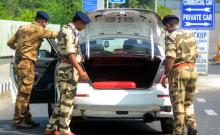
India on Thursday successfully test fired Agni-V, a solid fueled Inter-continental Ballistic Missile (ICBM), which is capable of reaching deep into Asia and Europe.
The indigenously built Agni-V with a range of more than 5,000 kilometers (3,100 miles) was test fired at Wheeler Island off Odisha coast at around 0807 hrs from Integrated Test Range (ITR).
Prime Minister Manmohan Singh called Defence Research and Development Organisation (DRDO) chief Dr V K Saraswat to congratulate him and his team for the successful test launch of Agni-V.
"DRDO and other organisations have worked tirelessly in our endeavour to strengthen the defence and security of our country. The nation stands together in honouring the scientific community who have done the country proud," said the PM through PMO twitter page.
The PM termed successful launch of Agni-V as a "milestone".
"Today's launch represents another milestone in our quest for our security, preparedness and to explore the frontiers of science," he said.
Defence minister A K Antony also congratulated DRDO chief Dr V K Saraswat over phone after the test was declared successful.
Sources said that Agni-V was originally scheduled to be launched on Wednesday but was postponed due to bad weather.
India has now joined elite nations that have Inter-continental Ballistic Missile capability. Till date, U.N. Security Council permanent members China, Russia, France, the United States and the United Kingdom have ICBM capability. Israel is also believed to have the capability.
The nuclear warhead-enabled Agni-V is 17 m long, 2 m wide and weighs 50 tonnes, and it can carry a pay-load of 1 tonne. It is an upgraded version of the indigenously built Agni series to be powered by solid rocket propellants. It is the fifth in the Agni series. India had earlier successfully test fired Agni-I (700-km), Agni-II (over 2,000-km), Agni-III (3,500 km- 5,000 km) and Agni-IV (of 2,500-3,500 km).
Sources said that DRDO has a series of plans on defence in the near future. The submarine-launched ballistic missile (SLBM) is expected to be operational by 1013 and a missile shield to combat drones by 2014. It is also working on quick-launch micro satellites and Star Wars-like laser weapons.

















